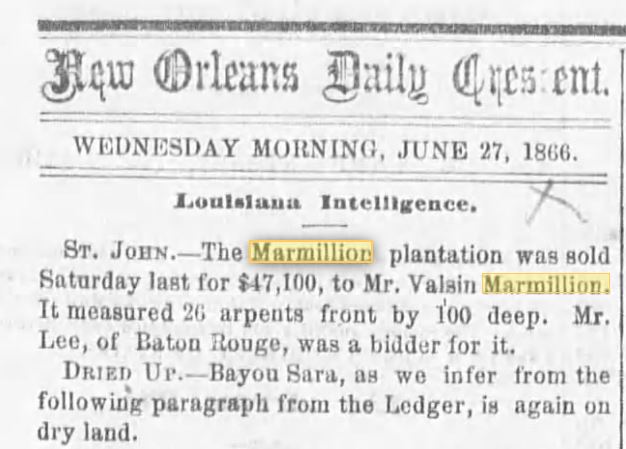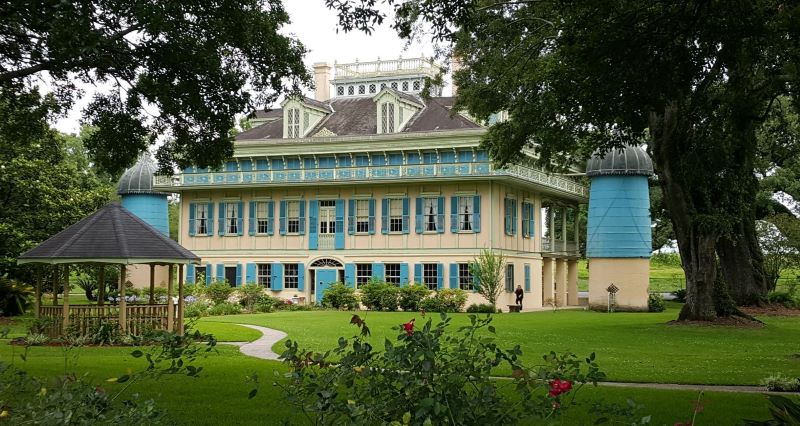Untangling the Marmillions, Part 2
Read Part 1 HERE
Naturally, with all these V.B.s, P.B.s, and E.B.s floating around, it makes research difficult, if not impossible to deduct who is who. For instance, a “V.B. Marmillion” was listed along with many other planters in St. John the Baptist Parish in The New Orleans Daily Crescent as being “of the old Creole-gentleman type – hospitable, chivalrous, and high-spirited.”[1] But, which one? Joseph Valsin or his nephew who owned San Francisco plantation and went by the same name? According to a formerly enslaved woman, Mrs. Webb, from the parish, “Valsin Marmillion” would take disobedient slaves and make them stand in a sweat box, “in which there were nails placed in such a manner that the poor creature was unable to move. He was powerless even to chase the flies or, sometimes, ants crawling on some parts of his body.” Mrs. Webb tells of another instance involving a boy who was purchased after the death of his prior owner and refused to be put to work in the fields. He was given one day to change his mind. When he didn’t, he was forced to dig an immense hole, in which he stood blindfolded and was shot. [2] This report from Mrs. Webb collaborates with the atrocities reported in Harper’s Weekly, painting Valsin Marmillion as a member of the immoral slaveholder class that upheld Confederate ideals. But which of the “Valsins” do these accounts come from? The uncle, who held more in bondage or the nephew who resented his status as a plantation owner?
As New Orleans became occupied by Federal troops, discerning which Marmillion did what also becomes problematic. There was a warrant issued for a “V.B. Marmillion’s” arrest on April 5, 1863, for requiring that merchants pay him a license fee to operate in the parish under the guise that he was the parish sheriff. The 1st Louisiana Volunteers were ordered to carry out the arrest.[3] No other record is found on the verdict of any trial or if he was acquitted. Could this have been the uncle who owned more land in St. John the Baptist Parish and therefore had greater influence in his community, or was it his nephew who was supposedly “Sans Frusquin” due to his extravagant renovations to his mansion home?

There is also a letter from Colonel Thomas Conway, Superintendent of the Bureau of Free Labor addressed to Captain Darling, confirming that “Mr. Marmillion” would be able to pay his workers for their labor in February 1865, “provided his lease runs out and that he continues during the month under Genl Banks regulation.”[4] Nathaniel Banks took over the occupation of New Orleans from Benjamin Butler in December of 1862. In April of 1863, it was announced that all slaves currently held in bondage would be officially free and that the recruitment of men for home guard duty would begin. Those who continued to work on the plantations would be paid “decent wages” and the properties would be leased to the government for one year.[5] When the overcrowding of contraband became an issue, Banks ordered that the blacks would need to return to the plantations – any they chose – and be paid either a fixed wage or be given a percentage of the yearly profits brought in by their labor.[6] Because of the ambiguity of “Mr. Marmillion”, this could be referring to Joseph Valsin, Valsin, or Pierre.
Which of the Marmillions served in the military becomes a little easier to figure out, as there are only a small handful of Confederate muster roles with that name. Neither Joseph Valsin nor Valsin the younger served in the Confederate army. Charles, Valsin’s brother, would go to fight for the preservation of the Confederacy and enlisted in Company G of the 10th Louisiana Infantry as a 1st Lieutenant, later promoted to the rank of captain.[7] His regiment fought in the famed Louisiana Brigade and participated in many of the Eastern Theater battles. He was wounded at Antietam in September of 1862 and was hospitalized in October of 1864 for syphilis in Lynchburg. Twice he was captured and a third time surrendered with Robert E. Lee at Appomattox. Dr. E.B. Marmillion also enlisted, but as a Surgeon with the rank of Major under the 1st Regiment, French Brigade of the Louisiana Militia, and presumably never left the state.[8]

Two additional men with the surnames of Marmillion from St. John the Baptist Parish are recorded to have enlisted with the 80th US Colored Infantry in August of 1864, though its inconclusive whether James and Adam came from the plantation of Joseph Valsin, Valsin, or Pierre.[9][10] An Adam was listed in the 1856 Slave Inventory with an approximate age that coincides with the enlistment record.[11] For an enslaved person to take the last name of their enslaver wasn’t a gesture of endearment to them, but a means to be found by departed family members who may come looking for them after freedom came. Another explanation for using the Marmillion surname came from the recruiters who filled out the enlistment papers, as some simply put down the last name of the freeman’s former enslaver instead of letting him decide on one for himself on the spot. Regardless, they both received bounties of $100 for their enlistment, and were joined by many more newly emancipated slaves from the surrounding plantations. The regiment spent the majority of 1864 policing their own backyards against Confederate guerilla and partisan raiding.

After the collapse of the Confederacy, the Marmillions never again enjoyed the same lavish income they earned while slavery was still legal. By the 1870 census, only Joseph Valsin and Valsin remained listed, as Pierre had died in 1866. Joseph Valsin was listed with land value of $60,000 and property listed at $40,000.[12] Upon the death of his wife, Mathilde, a dispute of succession arose between Joseph Valsin and Michel Becknel from Mathilde’s previous marriage, resulting in a sheriff’s sale of the plantation, announced in papers including the New Orleans Daily Crescent in May of 1866.[13] The result of the sale was that “Mr. Valsin Marmillion” purchased the bulk of the estate items, including the property, for $47,100.[14] Due to the names in this succession dispute, it’s clear that they are speaking of the older, Joseph Valsin, and not his nephew.

Valsin and Charles did not fair much better. In March of 1867, they leased out one third of their land in the settlement of another succession dispute with Marmillion relatives.[15] Valsin died of tuberculosis in 1871 – a fate that befell other family members – and Charles died of pneumonia four years later. Pieces of their property and estate were given away in other succession disputes in 1877.[16] Louise tried to keep the show going, but she caved and sold the plantation and its fields in 1879. She left Louisiana behind and took her three surviving daughters with her to Munich to live out the rest of their days.

Today, Joseph Valsin’s mansion no longer stands, but San Francisco has become a tourist destination, restored to its former, colorful Creole state by the Marathon Petroleum Corporation and owned by the San Francisco Plantation Foundation. Tours discuss the luxurious lifestyle of the Marmillions who lived there. Two cabins sit on the property. One represents the living conditions of the enslaved and post-emancipated families who stayed on the plantation, while the other had once been a free black’s school following the Civil War. Both cabins feature information signs and plaques to explain the story of life on these plantations for the enslaved, but are not heavily spoken of during the main tour.
Many plantation families along the Mississippi have complicated and tangled family trees, especially along what’s been coined the “German Coast” just outside of New Orleans. Due to traditional naming practices, it can become even more confusing to unravel the identities of enslavers between newspaper articles and census records. Regardless of which Valsin Marmillion was referred to in the testimonies of the formerly enslaved, like Mrs. Webb and Wilson Chinn, the Marmillion dynasty built their fortunes and reputations through the use of enslaved labor, as other plantation owners had. However, by looking deeper into the backgrounds and relationships of these plantation owners, we can better, more complete understanding of what life was like within their interconnected communities before, during, and after war’s end.

References
[1] “Louisiana In Slices; Paris of St. John the Baptist,” The New Orleans Crescent, April 30, 1860
[2] Interview by Harriette Michinard on 17 August 1940; Ronnie Clayton, Mother Wit. The Ex-Slave Narratives of the Louisiana Writers’ Project, p.208.
[3] Correspondence between Captain Provost Marshall James King and 2nd Lt Provost Marshall J.D. Rich, “Relative to one V.B. Marmillion claiming to be sheriff of Parish” March 22nd & April 5th 1863, Papers Relating to Citizens, compiled 1861 – 1867, Record group 109; National Archives, Washington D.C.
[4] Letter from Thomas W. Conway, Superintendent of the Bureau of Free Labor to Captain Darling, Jan 3rd 1865, Papers Relating to Citizens, compiled 1861 – 1867, Record Group 109; National Archives, Washington D.C.
[5] Winters, John D. The Civil War in Louisiana. Baton Rouge, LA: Louisiana State University Press, 1992. p. 190
[6] Ibid. p.208
[7] Compiled service record, Charles B. Marmillion, 1st Lieutenant, Company G, 10th Louisiana Infantry; Carded Records Showing Military Service of Soldiers Who Fought in Confederate Organizations, compiled 1903 – 1927, documenting the period 1861 – 1865, record group 109; National Archives, Washington, D.C.
[8] Compiled service record, E.B. Marmillion, Major-Surgeon, 1st Regiment, French Brigade, Louisiana Militia; Papers of and Relating to Military and Civilian Personnel, compiled 1874 – 1899, documenting the period 1861 – 1865, record group 109; National Archives, Washington, D.C.
[9] Compiled service record, James Marmillion, Private, Company H, 80th US Colored Infantry; Carded Records Showing Military Service of Soldiers Who Fought in Volunteer Organizations During the American Civil War, compiled 1890 – 1912, documenting the period 1861 – 1866, record group 94; National Archives, Washington, D.C.
[10] Compiled service record, Adam Marmillion, Private, Company H, 80th US Colored Infantry; Carded Records Showing Military Service of Soldiers Who Fought in Volunteer Organizations During the American Civil War, compiled 1890 – 1912, documenting the period 1861 – 1866, record group 94; National Archives, Washington, D.C.
[11] Inventaire communuate E.B. Marmillion & Jeanne Antionette Bozonier Marmillion, 14 May 1856 [SJB-165-1856]
[12] The 1870 United States Federal Census, the Nineth Census of the United States, St. John the Baptist Parish, Ward 2, Louisiana, files.usgwarchives.net/la/stjohnthebaptist/census/1870/ward2.txt
[13] “Sheriff’s Sales, V.B. Marmillion vs. Michel Necknel – No. 126”, New Orleans Daily Crescent, New Orleans, LA, May 24, 1866
[14] “Louisiana Intelligence, St. John,” New Orleans Daily Crescent, New Orleans, LA, June 27, 1866. “The Marmillion plantation was sold Saturday last for $47,100 to Mr. Valsin Marmillion.”
[15] “No. 312, In the matter of the tutorship of the minors Michel Alphonse Marmillion and Marie Jeanne Antoinette Marmillion,” Le Meschabebe, Bonnet Carre, LA, Mar 9 1867
[16] “Local Items,” Le Meschabebe, Bonnet Carre, LA, Jun 2 1877
Solid stuff!